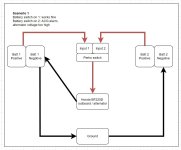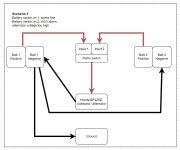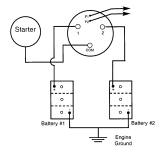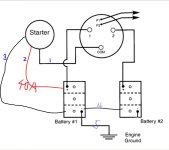Hi,
I have 2 batteries connecting to Honda BF225D outboard through a perko switch. When I use battery 1 to start the engine, everything was fine. When I switched to battery 2 to start the engine, the Honda ACG alert would beep continuously, indicating charging system is faulty. Use multimeter to measure and I got 16.9 volt which is consistent with the ACG alert -- alternator's output voltage is too high. The fact that battery 1 worked fine, I think alternator should be ok. The problem is probably battery 2 or the wiring related to battery 2.
The wire connection is a pretty typical and symmetrical with the exception that the black return wire from engine goes to battery 1 negative only (not terminal 2) , if I follow the wire:
when I use battery 1:
- battery 1 positive -> perko switch input 1 -> perko switch out -> engine/alternator -> battery 1 negative -> ground bus (connected to boat body) -> battery 2 negative
when I use battery 2:
- battery 2 positive -> perko switch input 2 -> perko switch out -> engine/alternator -> battery 1 negative -> ground bus (connected to boat body) -> battery 2 negative
To see battery 2 is good or not, I connected battery 2 this way and everything worked fine. This means battery 2 is not the problem.
- battery 2 positive -> perko switch input 2 -> perko switch out -> engine/alternator -> battery 2 negative -> ground bus (connected to boat body)
So the only culprit is a bad grounding somewhere along this path:
- battery 1 negative -> ground bus -> battery 2 negative
Is my assumption correct? Or are there other possibilities?
I cleaned all contact points with CRC contact cleaner carefully and tightened everything super tight, still the problem is there (battery 1 works fine, but when I use battery 2, I still got high voltage from alternator and ACG alarm). Worked on this all weekend and am stuck. I am absolutely clueless on what I can try next. Any suggestions?
Thanks a lot for your help!
I have 2 batteries connecting to Honda BF225D outboard through a perko switch. When I use battery 1 to start the engine, everything was fine. When I switched to battery 2 to start the engine, the Honda ACG alert would beep continuously, indicating charging system is faulty. Use multimeter to measure and I got 16.9 volt which is consistent with the ACG alert -- alternator's output voltage is too high. The fact that battery 1 worked fine, I think alternator should be ok. The problem is probably battery 2 or the wiring related to battery 2.
The wire connection is a pretty typical and symmetrical with the exception that the black return wire from engine goes to battery 1 negative only (not terminal 2) , if I follow the wire:
when I use battery 1:
- battery 1 positive -> perko switch input 1 -> perko switch out -> engine/alternator -> battery 1 negative -> ground bus (connected to boat body) -> battery 2 negative
when I use battery 2:
- battery 2 positive -> perko switch input 2 -> perko switch out -> engine/alternator -> battery 1 negative -> ground bus (connected to boat body) -> battery 2 negative
To see battery 2 is good or not, I connected battery 2 this way and everything worked fine. This means battery 2 is not the problem.
- battery 2 positive -> perko switch input 2 -> perko switch out -> engine/alternator -> battery 2 negative -> ground bus (connected to boat body)
So the only culprit is a bad grounding somewhere along this path:
- battery 1 negative -> ground bus -> battery 2 negative
Is my assumption correct? Or are there other possibilities?
I cleaned all contact points with CRC contact cleaner carefully and tightened everything super tight, still the problem is there (battery 1 works fine, but when I use battery 2, I still got high voltage from alternator and ACG alarm). Worked on this all weekend and am stuck. I am absolutely clueless on what I can try next. Any suggestions?
Thanks a lot for your help!























